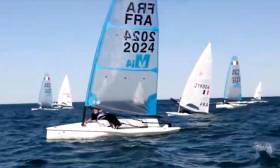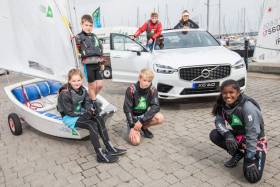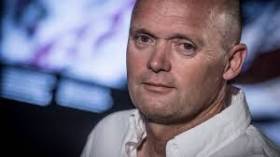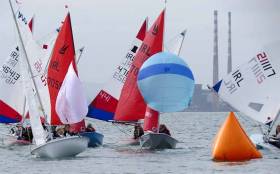Displaying items by tag: Olympic
Budget 2020 To Deliver Tokyo Olympic Funds & National Sports Policy
The Olympic Federation of Ireland today welcomed the announcement made by Minister Shane Ross and Minister of State Brendan Griffin that Budget 2020 will deliver on the progressively increased funding for Irish sport set out in the 2018-2027 National Sports Policy.
Special funding earmarked to support National Governing Bodies, such as Irish Sailing, Rowing Ireland and the Irish Canoe Union, in preparation for the 2020 Olympic Games is also very welcome at this juncture, less than ten months out.
Speaking today, Peter Sherrard, CEO of the Olympic Federation of Ireland said,
“We thank the Government for continuing to honour its funding commitment to sport under Budget 2020. Sport plays a vital role in society, with major health, social and economic benefits right across the country. Our international athletes sacrifice so much to represent us on the world stage and inspire so many young people to get involved. They deserve our support and we thank the Government for committing funding to their programmes under this Budget.
“While details are still to be announced by Sport Ireland in relation to the distribution of the funding, today’s Budget announcement provides the means necessary to continue delivering on the 2018-2027 National Sports Policy and that is very positive.”
From 11-15 March 2019, the D-Zero, Laser, Melges 14 and RS Aero were put through their paces at Sea Trials for the Men's and Women's One Person Dinghy Equipment for the Paris 2024 Olympic Sailing Competition.
World Sailing launched a tender process in May 2018 which invited Class Associations and Manufacturers to tender for the Men's and Women's One Person Dinghy.
Eight tenders were received and a Board of Directors appointed Working Party recommended that the Laser be included as a full option in the Sea Trials alongside the D-Zero, Melges 14 and RS Aero.
Real Club Nautico Valencia hosted representatives of each manufacturer and class as well as an evaluation panel and 11 international sailors with Olympic and World Championship experience.
The evaluation panel at the Sea Trials brought together a wide range of knowledge including members from the re-evaluation working party, World Sailing committees, Board of Director, Coaches Commission, Medical Commission and World Sailing technical team.
They will now write a report and make a recommendation on what equipment should be adopted for the Men's and Women's One Person Dinghy at the Paris 2024 Olympic Games.
This recommendation will be presented to the Equipment Committee at the 2019 Mid-Year Meeting in May. The Equipment Committee will review the recommendation and then make their own to World Sailing's Council, the final decision-making body of World Sailing, who will make a decision on the equipment that will be adopted.
Irish Sailing Performance ‘Volvo Junior Squad Programme’ Reactivated
Irish Sailing has announced the reactivation of the Irish Sailing Performance ‘Volvo Junior Squad Programme’, aimed at nurturing future talented Irish sailors.
The Irish Sailing Performance ‘Volvo Junior Squad Programme’ aims to develop and support talented young sailors, acording to a press release issued by the Irish Sailing Foundation.
It identifies and develops Irish junior sailors through training and coaching, introduces them to international racing, and prepares them for the next stages of their sailing career. The programme includes coaching and training on the water, but also on-shore workshops which look at sports psychology, fitness, nutrition, and physiotherapy.
Overseeing the Performance ‘Volvo Junior Squad Programme’ is Irish Sailing Academy Coach Ross Killian. The Junior squads are part of the Irish Sailing Performance Pathway which aims to nurture and develop sailors along a journey of six phases, leading ultimately to international regattas and Olympic level competition.
Three classes of boats will be included in the Performance ‘Volvo Junior Squad Programme’ – the Optimist, Topper and Laser 4.7 classes. Squad sizes will vary and will be selected through the programme’s application process.
London and Rio Olympic 49er crew Matt McGovern is moving to the position of helmsman in a new campaign for Tokyo 2020. Ballyholme Yacht Club (BYC) say the Belfast Lough star, who split from sailing partner Ryan Seaton at the end of last season, will now sail with former top Northern Ireland youth sailing performer Robbie Gilmore.
It's yet another skiff team for Ireland that could now see as many as four campaigns contest the single Tokyo slot. Afloat.ie reported earlier on the burgeoning Irish 49er scene here.
Carrickfergus Sailing Club's Seaton, also sailing with another top Irish youth sailor, Cork Harbour's Seafra Guilfoyle, has already declared that a Gold Medal in Tokyo is the target for their new north–south campaign. Seaton and Guilfoyle intend to make Mallorca this Spring their first event and have launched a crowdfunding campaign to raise the €5k to get them there.
Meanwhile, McGovern, who has swapped his crew position for the helm in the 49er and teamed up with the 2013 ISA Youth Champion Robbie Gilmore of Strangford Lough Yacht Club, is working hard, hitting the water six days a week to get the new NI campaign up to international speed.
2017 Irish Sailing Fixtures Preview
The only non-elitist thing about the Olympic Games is the fact that all countries – however large or small – are treated equally. A small country like Ireland is entitled to exactly the same number of places in competition as the superstates like the US or China. But apart from that, if any country’s national authority in any Olympic discipline is not treating its selected athletes as a pampered elite as an Olympic year arrives, then it is wasting everyone’s time. That’s how it should be in an Olympic year. But things definitely aren’t the same in the three clear years between each Olympiad. W M Nixon looks ahead to a completely different type of season in 2017.
Irish sailing had a good 2016 Olympics. Our waterborne elite did well - they did us proud. And the Irish national sailing season of 2016 – as we saw in last weekend’s review here – was special in many ways, for on top of Olympic success we staged two major world dinghy championships, witnessed perhaps the best ever Volvo Round Ireland Race, and brought home both silver and bronze medals from world youth championships.
That was how it was in 2016. But for 2017, we look forward to a very different kind of sailing year, in which everyone has the chance to be a star at local level, and our Olympic achievers and international medallists will be sailing as ordinary competitors along with everyone else.
 Olympic Silver Medallist Annalise Murphy racing her foiling Moth, with which she is expected to compete in the Cork Dinghy Fest at the end of June. Photo: VDLR
Olympic Silver Medallist Annalise Murphy racing her foiling Moth, with which she is expected to compete in the Cork Dinghy Fest at the end of June. Photo: VDLR
In these circumstances, it’s intriguing to look at some of the events which will set the tone for the coming year. And if by some chance you’re feeling jaded as we sink into the depths of winter, rest assured that it’s an absolute tonic to talk with the voluntary organisers who are heading up the groups which are putting together the various packages which will provide sailing happenings of all sizes from one end of the country to the other.
These people have a level of infectious enthusiasm which, if you could bottle it, would make you a fortune. Their zest in our sport, and their joy in boats and the sailing of them, is a wonder to behold. And they’re so keen on it that they’re prepared to put in so very many hours of their free time – hours beyond measure, in fact – in administrative effort, that it would put many professional organisers to shame.
Such enthusiasm can bring its own special problems. Every sailing centre round the coast and on the lakes will expect its share of the action. So inevitably there will be a clashing of dates which will make for difficult choices for crews who had specific programmes in mind. But this morning, we’re not in the mood to beat the drum about ruthlessly rationalising the national programme. Let’s just tell you what’s happening, and you can draw your own conclusions and plan out your own season.
That said, the big one is undoubtedly the Volvo Dun Laoghaire Regatta from the 6th to 9th July. 2015’s staging of this biennial festival experienced a quantum leap in the scale and scope of the event. Somehow, it moved onto a new plane. Under the chairmanship of Tim Goodbody, the organising committee built on the efforts of previous years, and the resulting myriad of sailing became a wonder to behold, and a joy to take part in. The plan for 2017 is to make it even better.
This outline hints at the scale of the event which will take place in July:
Volvo Dun Laoghaire Regatta 2017
Racing open to 30 Classes.
Incorporating the following Championships:-
· Royal Dee Yacht Club Irish Sea Offshore Championship
· Sigma 33 and Wayfarer National Championships
· Beneteau 211 Irish Championship
· GP14 and 420 Leinster Championships
· SB20 Southern Championship
· J24 & Squib East Coast Championships
Celebrating 200 years of Dun Laoghaire Harbour:
The Kingstown 200 Trophy for the best classic keelboat/dinghy.
NOR and Online Entry will open mid November (Monday November 14th).
Super Early Bird Entry Prize Draw: All entries received and paid for in full by 31 December 2016 will automatically be entered into a Super Early Bird Prize Draw and 10% of these lucky people will have their Entry Fee refunded.
To get the flavour of it, a chat with Organising Chairman Tim Goodbody at mid-week brought everything to life. That said, he was in a thoughtful mood, as that morning he had sold his much-loved Sigma 33 White Mischief after seventeen very happy and successful years. This enthusiasm in talking about their boats was found to be a shared characteristic of all the voluntary organisers, something which those who think the future of sailing lies in group-owned professionally-maintained boats might like to ponder.
Be that as it may, the J/109 class in Ireland will be taking on board the fact that their newest star entrant Tim Goodbody is now a hundred per cent J/109 man. For until he was comfortable in the knowledge that his Sigma 33 White Mischief had gone to a good home (she has found a lucky owner in Arklow), you had the feeling that a tiny bit of his mind was elsewhere as he campaigned the new White Mischief, a J/109.
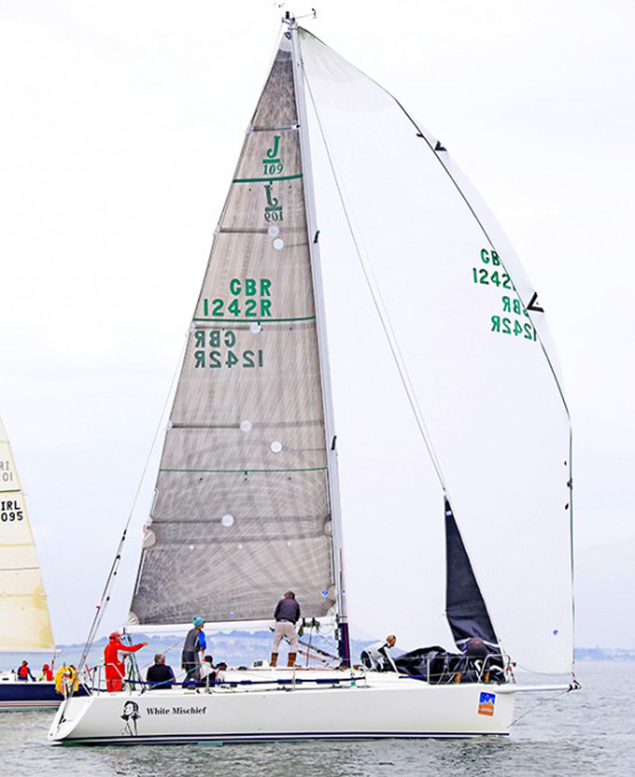 No longer a fleet owner…..Tim Goodbody’s J/109 White Mishcief is now his only racing steed. Photo: Afloat.ie
No longer a fleet owner…..Tim Goodbody’s J/109 White Mishcief is now his only racing steed. Photo: Afloat.ie
That said, he was frequently on the podium in the new class, but for Volvo Dun Laoghaire Regatta 2017 the rest of his crew will have to race as best they can without him, for he throws himself so thoroughly into heading up the large army of VDLR volunteers – with Ciara Dowling as an awesomely effective Executive Secretary – that there simply isn’t the time to think of campaigning in one of the hottest of the 30 classes as well.
A look at the heights of the 2017 programme shows how it is quite an achievement for the Volvo Dun Laoghaire Regatta 2017 to be the peak event at home, and it also reveals the difficulty for planning a programme for your boat and crew which will keep everyone – including the Commodore of your home club – in a happy frame of mind.
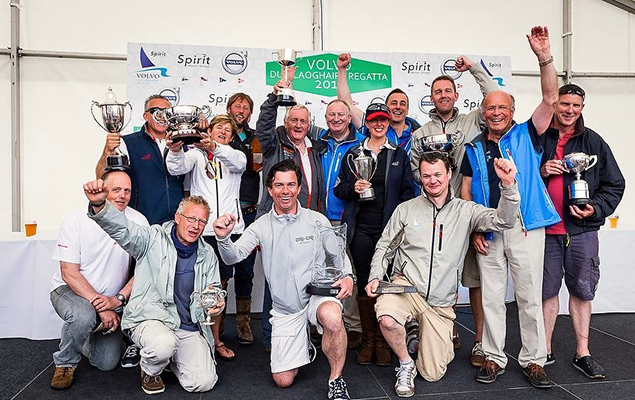
This list is by no means complete, but if you haven’t firmed up your club or association schedule by November, you’re not going to be taken seriously, as November is traditionally the month when the next year’s Corinthian crewing programmes take shape.
2017 Preliminary Programme
March 25th Horizon Energy Group PY1000 in Owenabue River at Crosshaven (RCYC)
May 26th – May 29th Scottish Series (Clyde Cruising Club)
June 3rd Lambay Races (Howth)
June 9th- June 11th ICRA Nats (Royal Cork)
June 14th Dun Laoghaire to Dingle Race (National YC)
June 21st to 24th Sovereigns Cup (Kinsale)
June 30th – July 2nd Cork Dinghy Fest 2017
July 6th to 9th Volvo Dun Laoghaire Regatta
July 6th to 8th WIORA Championship, Aran Islands
July 23rd to 28th Glandore Classics
August 1st to 4th Calves Week (Schull)
August 6th 2017 Rolex Fastnet Race
August 14th – 18th Half Ton Classic Worlds (Kinsale)
October 21st Rolex Middle Sea Race
We happen to know about the first rather esoteric major event on the programme, the PY 1000 dinghy race in the Owenabue River at Crosshaven on March 25th, thanks to the enthusiasm of Nicholas O’Leary of Royal Cork. He’s back on home ground and busy with being the third generation of his family in the energetic and imaginative organisation and promotion of sailing.
The Horizon Energy Group PY 1000 is a come-all-ye for dinghies using the Portsmouth Yardstick handicap. And they don’t mess about with prizes – there’s €1,000 on it. As the tides suit, they’ll be using the full available length and breadth of the Owenabue River between Crosser and Carrigaline in a crazy sailing project to blow the winter cobwebs away, and it will be a useful training for ogranisational energy levels as young O’Leary puts his team through their paces in training for the Cork Dinghy Fest at the end of June.
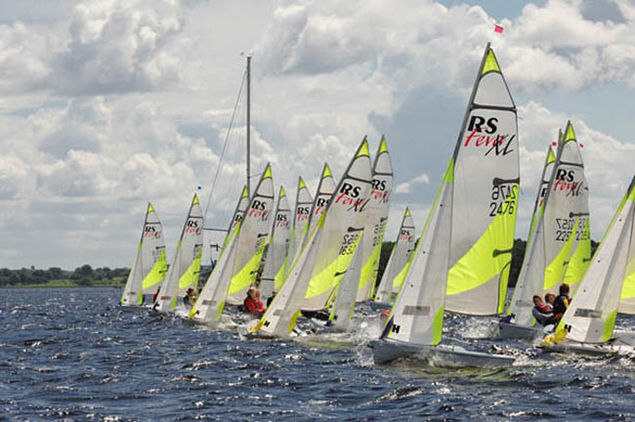 RS Fevas in a National Championship on Lough Ree. They’ll be gathering with other classes in Cork at the end of June 2017
RS Fevas in a National Championship on Lough Ree. They’ll be gathering with other classes in Cork at the end of June 2017
Like Tim Goodbody, he can be slightly sentimental about his boats – in his case, it was seeing an old and much-loved Optimist he’d once raced which fired him up to spread the news. An email from him this week gets the flavour of Nicholas O’Leary’s approach to sailing:
“Top of the organisational agenda is taking on the Dinghy Festival at the end of June on behalf of the Royal Cork Yacht Club and the dinghy fraternity of Ireland and beyond. My good friend Marty O’Leary is chairman of the RS Class in Ireland, and we will again welcome three fleets from under his wing - The RS200 for their Nationals and the RS400 and Feva Southerns.
The array of dinghy classes within Ireland concentrate on doing their own calendar year after year. This is a huge undertaking and requires massive dedication by class captains, regional reps and the clubs that host. The Dinghy Fest takes the stress off such class reps for one of many events they would normally have to organise, and brings together the masses into one harbour to enjoy great racing and great craic ashore, particularly as it provides socialising with friends they haven’t seen due to other class commitments.
We are working on connections within the variety of classes nationwide, and one exciting grouping that we’re planning is an Extreme Fleet. To see one 49er screaming across Cork Harbour is a sight, but we plan to have one race course dedicated to an entire fleet of fast dinghies, with the foiling Moths - where we hope to see Olympic Silver Medallist Annalise Murphy racing against her coach Rory Fitzpatrick - as well as 29ers and 49ers, and the Cat class, with the Catamarans demonstrating their viable concept of mixed craft racing on the one race track, and results divided thereafter.
I know this Extreme Fleet will open the eyes of young sailors to see that there is life after an Optimist, 420, Laser or whatever fleet they are currently in, and that fast fun boats are accessible classes, alive within Irish waters. I sincerely think it’s very important for the future of youth sailing that they enjoy it, finding a class they are happy in rather than being marched up to the gates of a pathway and pushed through. Those who enjoy the sport will stay in the sport. If they excel to greater heights, then so much the better, but that shouldn’t be the be-all and end-all for everyone.
I don’t believe the success of an event is within its number of entries, but in its quality of racing provided. That is why my old housemate and current ISA Champion of Champions Alex Barry is joining our team in an advisory role to keep the high standard of racing up to scratch, and in line with what we would expect when racing Worldwide. I look forward to developments in the months to come, and will of course keep everyone updated with sailing news from near and far.”
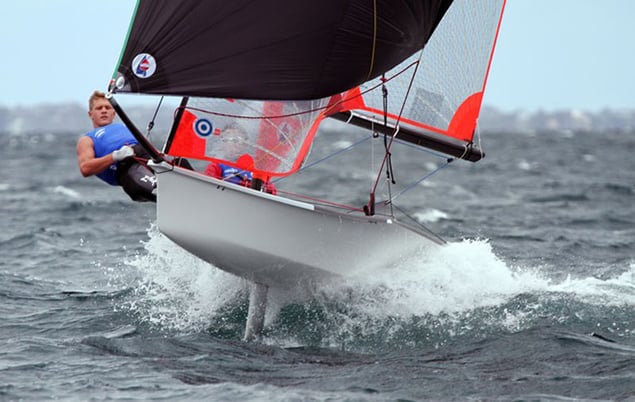 29er in flight. Nicholas O’Leary, organiser for Cork Dinghy Fest 2017, hopes that the presence of 29ers will encourage more young sailors to realize that boats like this aren’t only for the elite
29er in flight. Nicholas O’Leary, organiser for Cork Dinghy Fest 2017, hopes that the presence of 29ers will encourage more young sailors to realize that boats like this aren’t only for the elite
So the dinghies of Ireland have the good example of somebody thinking in a far-sighted and coherent way. But with the offshore racers, the picture is as ever more complex. Yet it’s for sure we’re interested in the Scottish Series out on its own in May, as we provide the ex-Pat overall winner Dara O’Malley (originally from Westport, he’s Edinburgh-based) with his Hunter 707 Seaword in 2016, while regular contender John Hall from the National YC won Class 2 with his J/109 Something Else.
But in June things get mighty complicated, as there are two major cruiser-racer championships in Cork with a clear fortnight between them, yet during that fortnight the biennial Dun Laoghaire to Dingle race gets under way.
However, if you talk with the enthusiasts involved in organising any of these events, it all seems very manageable. Paul Tingle who is chairman to organise the ICRA Nats at Royal Cork from June 9th to 11th has recently moved from campaigning a Corby 25 with family and friends to the comparatively luxurious yet equally competitive surrounds of an X 34 which will also be called Alpaca. He sees the ICRA Nats at Crosshaven from June 9th to 11th as offering the special cachet of a National Championship in a manageable package. And at the end of it your boat is conveniently placed to be moved to Kinsale the following weekend for the time-honoured Sovereign’s Cup series the weekend after (June 21st-24th)
 Kinsale is pulling out all the stops to make the Sovereign’s Cup fleet welcome from June 21st to 24th.
Kinsale is pulling out all the stops to make the Sovereign’s Cup fleet welcome from June 21st to 24th.
In fact, Paul Tingle and his counterpart at the Sovereign’s, Kevin Murray of Kinsale, are coming up with all sorts of ingenious suggestions for getting the boats from Crosshaven to Kinsale, ranging from a passage race to a simple offer to provide voluntary delivery crews. The thinking is that some crews and owners will welcome the opportunity for a weekend off to score some brownie points on the home front. But however they get to Kinsale, the participants in the Sovereign’s will find that the entire town is behind the event, which is very much aimed at being a fun happening.
Freed from the constraints of the IRC limitations within ICRA, Kinsale YC can open the door to sportsboats and even inshore keelboat classes, should they be so interested, and the emphasis is going to be very much on a regatta atmosphere rather than the more serious mood of a national championship.
Meanwhile, take note that the Dun Laoghaire to Dingle race is on a Wednesday evening – June 14th – not the Friday evening as in 2015. The feeling is that in these demanding times, it make more sense to slip away from business cares on a Thursday and Friday to get comfortably finished racing by Sunday and probably earlier, rather than arrive in the office exhausted on a Tuesday after a 380-mile race which finished in the small hours of Monday morning. Last time round, it was J boats of several sizes which dominated, with the Shanahan family’s J/109 Ruth winning from sister-ship Mojito, but maybe in 2017 some other marque will get a look in.
For July, an east-west divide arose in planning the programme, when the fascinating concept of a West of Ireland Offshore Racing Association Championship on the Aran islands made the discovery that out in Kilronan, each summer weekend is spoken for in terms of hosting some major island festival. Thus the only clear one they could offer hyper-keen Atlantic Way sailor Cormac MacDonnacha of WIORA was July 8th & 9th, and as his fleet will be wanting to make their way home along the Atlantic seaboard on the Sunday, the WIORA Championship 2017 is July 6th to 8th. It will make for a painful decision for some crews who had hoped to go east for the big one in Dun Laoghaire taking place at exactly the same time.
The Rolex Fastnet Race next year is earlier in August than it has been for some time, going off on Sunday August 6th. And among the fleet will be an Irish boat defending a trophy won in 2015, the Jeanneau 37 Desert Star skippered by Ronan O Siochru of Irish Offshore Sailing of Dun Laoghaire. Desert Star was right on the podium among the many Irish boats in the previous race, and she was also overall winner of the Sailing Schools trophy, besting 32 other boats.
 Desert Start round the rock during the Rolex Fastnet Race of 2015, on her way to winning the Sailing Schools Division in a fleet of 33 yachts. Photo: Rolex
Desert Start round the rock during the Rolex Fastnet Race of 2015, on her way to winning the Sailing Schools Division in a fleet of 33 yachts. Photo: Rolex
This was a notable success which underlined just how significant the concept of Fastnet Race experience has become in the definition of genuine seagoing ability. The camaraderie which developed among Desert Star’s crew of rookies from an extraordinary variety of backgrounds was heart-warming to behold, and it’s something which many wish to experience and share.
It’s very much what we hope for 2017, as it’s the perfect example of sailing for more ordinary folk rather than top level competition for superstars. So as we snuggle down into winter with just the special Frostbite, Brass Monkey and Turkey Shoot races available for those who want the occasional quick taste of sailing all year round, spare a thought for those dedicated souls who are so keen to get involved that they’ll go to sea just whenever they can, and that includes going offshore in the depths of winter.
For those dreamily contemplating next season from a comfortable armchair in front of a roaring fire, here’s a thought-provoking email I received last Sunday from Ronan O Siochru:
“We are flying downwind with a poled-out headsail
and double reefed main, 30 knots behind us in absolutely glorious sunshine
from Kilkeel back to Dun Laoghaire.
The guys are after sailing 500 miles in six days, and have been to Wales, the Isle
of Man, England, and Northern Ireland. We have also experienced the raw energy
of the North Channel and the Scottish sea state in November as we headed up to
Cambeltown on the Mull of Kintyre.
They are getting some of the most intense, gruelling training in difficult conditions - cold, 16 hours of darkness each day, and sometimes very fast-changing weather. We haven’t seen another sailing boat in 500 miles, as we left Dun Laoghaire in the dark and haven’t been back since.
They are doing serious training, and are learning so fast they are really closing in on many so called 'experienced’ sailors who have been sailing for decades.
They are an interesting group coming from a variety of backgrounds, a
totally international crew, and all guys on this occasion - Irish, French, English, Italian and a Canadian. Their reasons for being here range from a Canadian naval architect looking to learn to
sail, to a Frenchman taking early retirement with a dream to cash in his
pension to buy a catamaran and do charters in the Caribbean.
And there are a few young bucks
keen to avoid university, and instead sink their teeth into a grittier more active
career……The course has been running since 3rd September, and culminates in the RYA
Yachtmaster Offshore exam on the 26th November. Meanwhile, roll on 2017. The Fastnet calls.”
 A selfie by Fastnet Race class winner Ronan o Siochru with his crew of trainee yachtmasters as they experience their first easy sailing on the final leg last Sunday from Kilkeel to Dun Laoghaire.
A selfie by Fastnet Race class winner Ronan o Siochru with his crew of trainee yachtmasters as they experience their first easy sailing on the final leg last Sunday from Kilkeel to Dun Laoghaire.
Honouring An Olympic Sailing Gold Medal of 68 Years Ago
These days Dermot O’Flynn, Director of Training in the Royal College of Surgeons in Ireland, does much of his sailing in a classic Water Wag dinghy in Dun Laoghaire and Dublin Bay. But he is a man of wide-ranging nautical experiences and interests, and he has a gem of a story to share with us here:
In life you get some opportunities to do the right thing, and for me this was one of them. In January 2014 my father Dermot O’Flynn, past President of the Royal College of Surgeons in Ireland, died suddenly at the wonderful age of 94. A father, a great surgeon, and a yachtsman who enjoyed any opportunity to be out and about near or on the sea, he left me many happy memories. And he also left me an Olympic Gold Sailing Medal from the 1948 London Olympic Games (understandably known as the Austerity Olympics) which was won by Jim Weekes, who had crewed on the winning American 6 Metre Llanoria.
She was designed by Sparkman & Stephens, and owned by Herman Whiton, who was a member of Seawanhaka Yacht Club on Long Island, New York. On the crew registration for the 1948 Olympics, Jim was listed as James Weekes and the rest of the crew from Seawanhaka Yacht Club were Herman Whiton, Alfred Loomis (who was one of the leading sailing journalists of his day), Michael Mooney & James Smith.
 The veteran but beautifully restored Llanoria, European 6 Metre Classic Champion 2016
The veteran but beautifully restored Llanoria, European 6 Metre Classic Champion 2016
The 6 Metres were the largest and most prestigious of the yachts competing in the 1948 London Olympics, which also included Dragons, Swallows, Stars and the 12ft Firefly dinghy. The famous Danish sailor Paul Elvstrom won his first Gold Medal that year sailing a Firefly dinghy, so Jim and the crew were in good company.
My father was gifted the Medal in 1981 by James Weekes’ wife Kay, who had a been a long term patient and friend of my father. In the accompanying letter she wrote:
“This token comes with my deep affection, no other man deserves it better other than the one who won it, there are no sailors in my family, hand it down to one of yours when the time comes”
My father made the decision to hand down the medal to me probably because I survived the Fastnet Race in 1979 in a 30ft racing yacht, sailed across the Atlantic in 35-foot Camper & Nicholson sloop in 1981, managed a second overall in The Middle Sea Race, and loved sailing all types of boats whether they be dinghies, IRC racing machines, or classic cruising yachts. Yet after putting the medal under lock and key for a while, I came to the decision that the medal did not belong to me or my family, but should be returned to Seawanhaka YC, and so my journey started. Very quickly I discovered that there was only one living relative, named Townsend Weekes, who was also – surprise surprise….- a member of Seawanhaka YC, and he was delighted to hear the medal would be coming home.
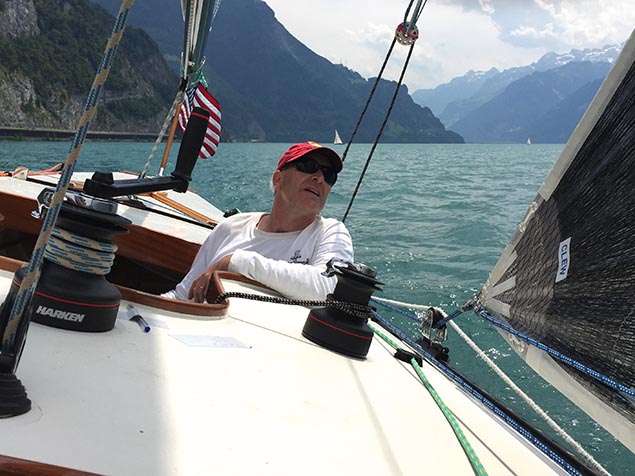 Dermot O’Flynn helming Llanoria on Lake Lucerne, July 2016
Dermot O’Flynn helming Llanoria on Lake Lucerne, July 2016
Townsend informed me that Jim was originally from Oyster Bay, Long Island, New York. He had three siblings, and the family have a long history with Oyster Bay, dating back to 1653 when Francis Weekes settled there. Jim’s grandfather was one of the earliest members of Seawanhaka Yacht Club, and both his brother Arthur and brother in-law Porter were Commodores of this yacht club.
Jimmy - as the family called him - was a terrific athlete who loved sailing and was the best rifle shot of his three brothers. Like his brothers, he had a distinguished career in the American Navy in World War 2, becoming an Executive Officer on a battle cruiser in the Pacific.
Nobody can remember how Jimmy got selected to sail on Llanoria for the Olympics in 1948 but obviously Herman Whiton liked the ‘cut of his jib’, and the Gold Medal sealed the success of their mutual respect.
James Weekes married Kay in 1962, and they moved to Dublin as they wished to live in Ireland, but sadly Jim died suddenly in 1977 at the age of 65. Kay and James had no family, however Kay had family from her first marriage, and they and other Weekes relatives in America had always wondered what happened to the gold medal, so they were intrigued – to say the least - to hear where it had ended up.
Having discovered the background to Jim Weekes, naturally my attention was drawn to the great Llanoria US 83, and what might have happened to her. My journey started by accident when I was delivering an Alden 54 called Tara from St Petersburg to Stockholm via the Finish Archipelago. We happened to spend two wonderful nights on the marina of Helsinki Yacht Club and the club has a half model of Llanoria, plus a photo of her winning the Seawanhaka Cup, for Llanoria had also won the 6 Metre Class in the 1952 Olympics in Helsinki – she is the only yacht to have won two Olympic Gold Medals.
My next port of call was the famous yacht designers Sparkman & Stephens in New York. They very kindly went through their records and found a line drawing of the yacht designed by Olin Stephens which they sent to me, however at that time they had no record of Llanoria’s present location.
But I kept digging for more information, and finally got in touch with Matt Cockburn, secretary of the Puget Sound 6 Metre Association in America’s Pacific Northwest, who gave me the great good news that Llanoria had been totally refurbished by her current owner Peter Hofmann, whose family had purchased her in 1980, and that she had just won the 6 Metre 2015 World Championships (Classic Division) at La Trinite Sur Mer on France’s Biscay coast, helmed by Eric Jespersen.
 Reception at the Seawanhaka Yacht Club on Sunday October 2nd to hand over the James Weekes Memorial Trophy
Reception at the Seawanhaka Yacht Club on Sunday October 2nd to hand over the James Weekes Memorial Trophy
I then contacted Peter Hofmann who was fascinated by the story of the Medal, and he kindly agreed to me joining him and the crew of Llanoria for a sail as they prepared for the 6 Metre European Championships on Lake Lucerne in July 2016. What a joy it was to sail with a crew who knew their yacht so well, and to watch them tune the rig, adjust the sheets, move the mast and create the perfect sail shape for 6 Metre sailing in 8-10 knots of breeze.
Now it was time to move on to the next stage of the Gold Medal’s journey home. In memory of James Weekes I agreed with the Seawanhaka Yacht Club Commodore, Vice Commodore and Committee, through a Deed of Gift, to present the Medal to the Club as ‘The James Weekes Olympic Gold Memorial Trophy’
The trophy represents the coast line of Torbay on England’s south coast, venue of the 1948 Sailing Olympiad, in Irish Silver, with the Gold Medal suspended in the centre of the 1948’s 6 Metre racing area. It is placed on a piece of Irish Bog Oak which is more than 800 years old, chosen for the very personal reason that on the day my father died, his parish priest said to me on hearing the sad news: “Dermot, a great oak has fallen”
At the beginning of October, it gave me and my family great pleasure to present this Memorial Trophy to Seawanhaka Yacht Club, and l look forward over my lifetime to hearing about the sailors who win this trophy, and their successes both on and off the race course.
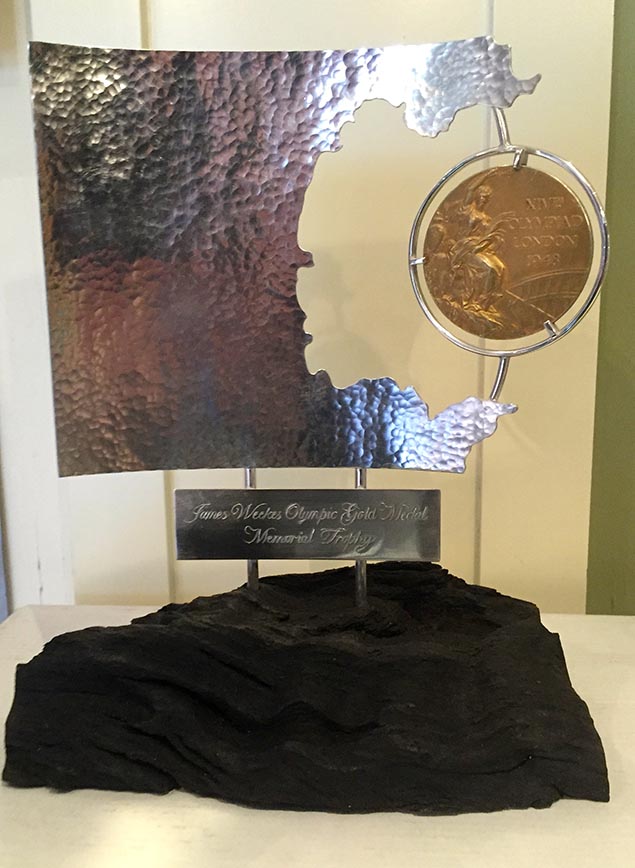 The James Weekes Olympic Gold Medal Memorial Trophy honours many cherished memories 68 years down the line since the Torbay Olympics.
The James Weekes Olympic Gold Medal Memorial Trophy honours many cherished memories 68 years down the line since the Torbay Olympics.
Irish 49ers Are Ahead of the Curve
Is it a bird, is it a plane? The International 49er Skiff is twenty years old in 2016, and it has been part of the Olympics since 2000. Yet for most sailors it is still as modern and bewildering as the day after tomorrow. W M Nixon tries to make sense of a class which finds itself in a good place in Ireland at the moment.
It doesn’t do to think too hard about the slim 16ft 49er skiff. Almost immediately you’ll jump to the conclusion that it’s actually a trimaran which is still awaiting the fitting of its floats. And then, when you see them zooming along at full speed with all three sails pulling in perfect unison and the crew of two exactly horizontal and cool as you please on their trapezes, you can’t help but think that it’s all too good to be true, for what they’re doing is equivalent to balancing – indeed ballet dancing - on the head of a pin, and the slightest error will lead to a sudden and almighty mess.
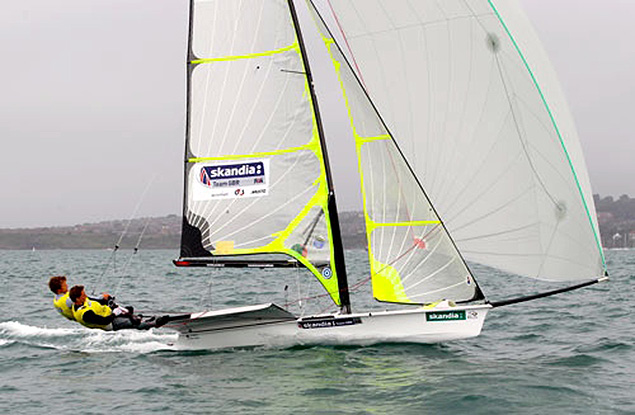 The 49er ideal – perfect balance, minimal spray, maximum speed
The 49er ideal – perfect balance, minimal spray, maximum speed
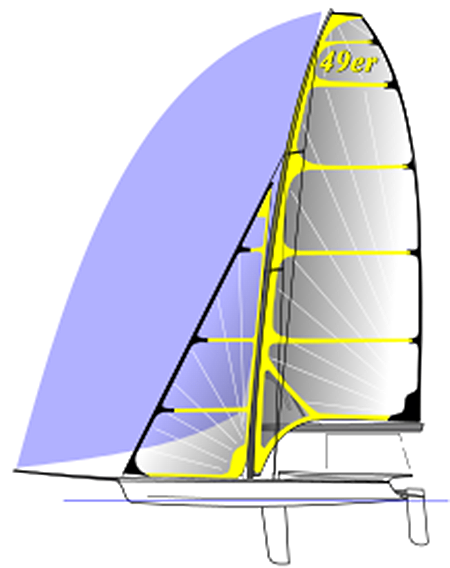 The 49er still looks more modern than the day after tomorrow
The 49er still looks more modern than the day after tomorrow
In thinking that, you’d be absolutely right. When everything is in the right place and functioning smoothly, the 49er is an impressive sailing machine. But when she goes head over heels or whatever you want to call it (the word “capsize” is much too tame), everything seems to get fouled up with everything else, and unravelling it all can take for ever.
There’s one particular trick of the 49er which sums up the challenge of sailing these very special Olympic boats. The hulls are just slips of things, with only the minimum of buoyancy needed to get them up to speed, and then as the speed confers extra buoyancy, you’re in business. But in that crucial moment as you break out the assymetric in a proper breeze before working speed develops, you might just see the bow dipping a little, then the nose goes that tiny bit under water, and things go from bad to worse in an instant. You’re going down the mine. And a very deep mine it can be too.
So you might wonder why the 49er is ringing a bell in Ireland at the moment. It’s clearly a specialist interest, and there’s no denying that those who can make a good fist of sailing it are an elite. Furthermore, it really only makes real sense when seen as an Olympic class, which makes it about as different as possible from the trusty old Laser at the bottom of the garden, the only boat to succeed in being an Olympic class while continuing to be universally popular with a huge variety of users at the same time.
Thus the 49er and its adherents are in a sort of parallel universe which only actively intersects in three ways with the rest of us. The main one is when the buildup to the Olympics and the Olympics themselves are topping the headlines, and the other two are when there’s a major global championship involving the 49er, possibly at a nearby venue, while the third is when the special group of 49er trainees under the ISA Performance Scheme are in Ireland on one off their fortnight-long training camps, as is happening at the moment at the National Yacht Club in Dun Laoghaire.
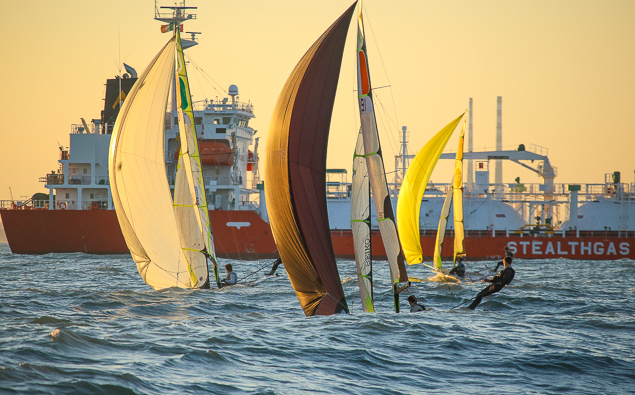 Ireland’s core 49er Training Squad in action in Dublin Bay this week – in foreground are Sean and Tadgh Donnelly, beyond are Robert Dickson and Sean Waddilove, and Oisin O’Driscoll and Mark Hassett. Photo: Afloat.ie
Ireland’s core 49er Training Squad in action in Dublin Bay this week – in foreground are Sean and Tadgh Donnelly, beyond are Robert Dickson and Sean Waddilove, and Oisin O’Driscoll and Mark Hassett. Photo: Afloat.ie
 A word with the coach – Schull’s Oisin O’Driscoll and Mark Hassett with Tytus Konarzewski. Photo: Afloat.ie
A word with the coach – Schull’s Oisin O’Driscoll and Mark Hassett with Tytus Konarzewski. Photo: Afloat.ie
It’s unusual, as many of the training camps have tended in recent years to be based during our winter at Cadiz in southern Spain. But don’t go along to the National YC this weekend expecting to see an array of 49ers. For a start, training sessions are a rather private affair. But as it is, we’re talking specialist numbers in dedicated highly-trained small groups, and to best understand that, a quick canter through the history of the 49er helps.
The modern skiff emerged from the legendary Sydney Harbour 18 footers which raced for impressive money prizes on that wonderful stretch of city-surrounded water, the racing closely followed by big harbour ferries crowded out with spectators betting like crazy on the results. In the early days, the quest for speed was met by crowding on ever more sail and somehow fitting aboard ever more crewmen to hang out as best they could – sometimes on each others shoulders – to keep the whole show on the road. And if they happened to capsize in a harbour whose waters might include a man-eating shark or two, not to worry – by this stage the sail areas had become so enormous it was reckoned the vast spread of white cloth on the surface of the sea would frighten away even the hungriest shark.
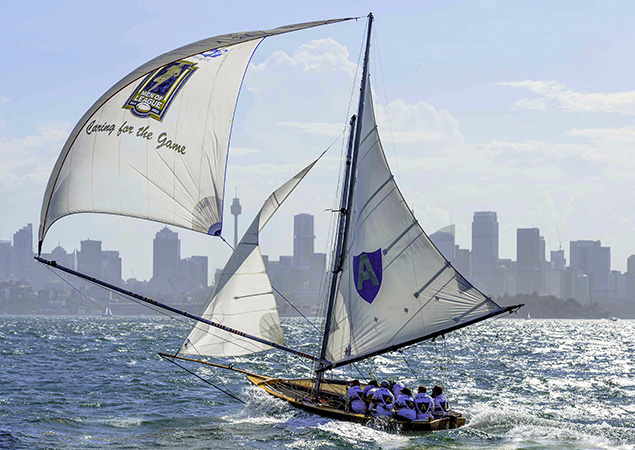 When power and weight mattered – a well-crewed Sydney Harbour 18-footer in all her glory. As designers learned that less is more, the leaner skiff concept emerged.
When power and weight mattered – a well-crewed Sydney Harbour 18-footer in all her glory. As designers learned that less is more, the leaner skiff concept emerged.
The rest of the world had just become used to these mad Sydney sailors using colossal sail area and moveable human ballast to achieve speed when the Aussies with innovative geniuses like Frank Bethwaite started to go the other way. The boats were still 18ft long. But with trampoline-like wings either side and a smaller crew hung out on trapezes, better speeds could be obtained with much less fuss. The Sydney Harbour 18ft skiff was re-defined, and with the 2000 Olympics scheduled for Sydney, the idea that a modern purpose-developed skiff would make an ideal Olympic sailing boat gained traction.
Or at least that’s how it all looks in hindsight. Doubtless there are as many narrative versions of how it all really came about as there were skiff types which showed up for an official Olympic Skiff selection trial on Lake Garda in 1996. What we do know is that the 49er skiff, designed by Julian Bethwaite of Australia and built by Dave Ovington in the northeast of England, emerged head and shoulders above everything else. And unlike a much earlier time when selection trials for a three man Olympic keelboat somehow saw the Soling being selected despite the fact that the Etchells 22 was clearly the better boat, this time righteousness prevailed, and the 49er made her Olympic debut just four years later.
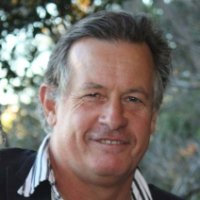 Julian Bethwaite, designer of the 49er
Julian Bethwaite, designer of the 49er
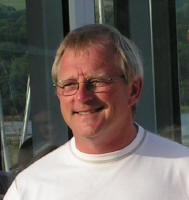
That in itself was something of a miracle of productivity, as the 49er has settled down with just two main builders worldwide, Ovington in England and MacKay in New Zealand.
That things were a bit hectic with larger-than-life characters in the early days goes without saying, and Irish sailing kept intersecting with it in a tangential way. Thus Gerry Donleavy of Dun Laoghaire, whose notable sailing CV incudes the British & Irish Flying Fifteen titles, found himself in 1990 at the FF Worlds in Brisbane, Australia, and among the boats he was racing against was one crewed by Dave Ovington from Newcastle in the northeast of England. Dave was a noted builder of Flying Fifteens (for which Gerry was Irish agent) and other racing machines, with Ovington’s career given an early rocket-assisted start when he built an all-conquering Enterprise dinghy for a rising talent called Lawrie Smith.
There was a layday during those 1990 Brisbane FF Worlds, and the competitors were taken off on a river cruise which included watching the local skiffs racing. Ovington was completely hooked by the whole skiff concept. He soon linked up with the formidable brains of the Bethwaite family to work towards production, but as Julian Bethwaite – son of the legendary Frank - is a perfectionist and endless experimenter all in one, it reputedly took at least five years of trialling and testing before he was satisfied with what eventually became the aft end of the new 49er.
Nevertheless the new machine was ready enough for Lake Garda in 1996, and the rest is history. But so too alas is Dave Ovington. The production rate for his surprisingly small “factory” in North Shields on Tyneside close east of Newcastle was already prodigious, with a selection of superb racing craft, yet he and the other builders managed to meet most of the demand for 49ers for the 2000 Olympics, and things were in running order for the 2004 Games as well.
But the pace was literally killing. In 2005, while getting ready to go out for a family sail on Lake Windermere, Dave Ovington dropped dead with a heart attack. He was only fifty. His sudden departure brought home a realisation of all that he had done in creating a world focus of top quality racing boat building in the unlikely setting of Tyneside, using dedicated local labour – only around fifteen in all - which he trained to be among the most talented boat-makers in the world, despite the fact that many of them don’t sail.
Dave Ovington left quite a legacy, and the continuing success of Ovington Boats is tangible evidence of it, with the company run by a dedicated triumvirate of three executives. Gerry Donleavy says he never fails to be impressed by the good working atmosphere in a plant producing top-level boats on which an entire nation’s Olympic hopes will rest, and it’s the reassuring structure on which the 49er Class is based which has led to the ISA Performance Director James O’Callaghan making such a strong commitment to the class.
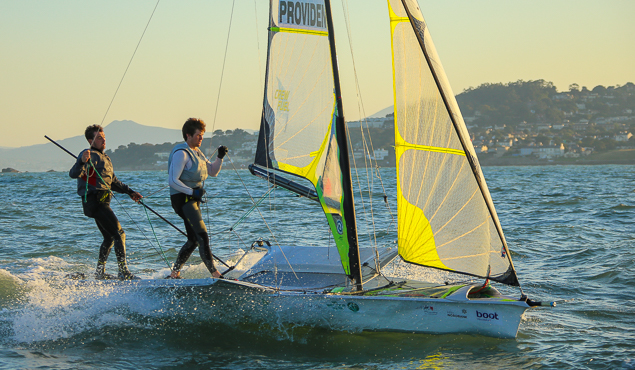 A long way from Schull. Mark Hassett and Oisin O’Driscoll in this week’s Dublin Bay 49er Training Camp. Photo: Afloat.ie
A long way from Schull. Mark Hassett and Oisin O’Driscoll in this week’s Dublin Bay 49er Training Camp. Photo: Afloat.ie
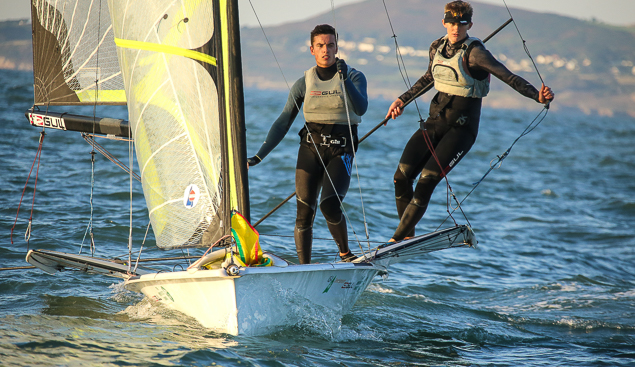 Sean Waddilove and Rob Dickson make up one of the ISA’s three core 49er crews. Photo: Afloat.ie
Sean Waddilove and Rob Dickson make up one of the ISA’s three core 49er crews. Photo: Afloat.ie
“We have to operate on a tight budget” says O’Callaghan, “and the 49er offers great value. It’s absolutely standardised, you just buy the boats and the parts and the sails off the shelf, and you know it’s a level playing field after that. With some other non-single-handed Olympic classes, there’s too much choice, too many builders involved. But with the 49er, the unknowns are taken out of the equation, and you can get on with planning and implementing a training programme relatively untroubled by boat issues”
In keeping it that way, the 49er Class worldwide has benefitted from Irish experience in running sailing organisations. Marcus Spillane (42) hails from Cork and a Crosshaven sailing background, but this past week he has been putting the final details into place in his new base in San Francisco after several gloriously busy years at the top end of some very exciting business ventures in New York. It’s said of running your own business that if you’re not having fun or making a lot of money, then why are you doing it? But Marcus Spillane seems to manage to do both, and he fits in quite a bit of sailing while he’s at it, having got involved with the Laser 2s in UCC both as sailor and then longer term as an administrator, through which he met Laser 2 designer Frank Bethwaite (who unlike Dave Ovington, lived to a lively 92) and his son Julian.
 Marcus Spillane, President of the International 49er Class, has this week been confirmed as President of the International NACRA 17 Class.Spillane’s other sailing has included Fastnets and Round Irelands and a lot of Etchells 22s and other racing in America (he’ll be doing the Caribbean 600 next February in a Swan 66), but as well he somehow found the time to include the 49er, and has great memories of fun championships with the congenial ISA coach Rory Fitzpatrick as crew.
Marcus Spillane, President of the International 49er Class, has this week been confirmed as President of the International NACRA 17 Class.Spillane’s other sailing has included Fastnets and Round Irelands and a lot of Etchells 22s and other racing in America (he’ll be doing the Caribbean 600 next February in a Swan 66), but as well he somehow found the time to include the 49er, and has great memories of fun championships with the congenial ISA coach Rory Fitzpatrick as crew.
Yet even a couple of minutes of talking with Marcus Spillane will reveal that he has more useful ideas about how sailing generally and its specialist sectors can be properly run than a whole committee room full of blazers. So naturally he was soon drafted into the admin side of the 49er on a voluntary basis, he then became the class’s World CEO in addition to his multiple other activities in business and sport, and in 2012 he was elected President of the International 49er Association with colleague Ben Remocker of Canada as Class Manager.
By this time the 49ers had gone through a re-vamp to improve the value and boat appeal which James O’Callaghan – who had been appointed ISA Performance Director in 2006 – rates so highly. While the basic concept remained the same, it was agreed that there had been so many advances in sails, spars and rigs in sailing generally that in order to reinforce the 49er’s image as being cutting edge, the rig should be up-graded and the one design nature of the hull should be put beyond all question.
This was done in 2009, resulting in the 49er we see today, based on a hull from master-moulds made only by MacKay, but producing boats in the Northern Hemisphere with Ovington, and in the Southern with MacKay, under a production programme so tightly controlled that you could argue the modern 49er is the world’s first true one design.
Of course it’s still a minority interest as a boat to sail, even if what happens in the class afloat and in the training camps is increasingly a matter of pubic interest. At a major championship in North America they might expect to see 80 boats, if it’s a major international championship held in Europe (where the class’s ancestral home of Lake Garda is a popular venue) you can expect 120 boats.
Yet so much is at stake among those 120 boats in international terms that the efficient running of the class worldwide is vitally important, and for the past four years the Spillane/Remocker duo have been making such a good job of running the International 49er Association that as of Wednesday night this week they have also taken on the running of the new Olympic class, the 2011-designed NACRA 17 Catamaran, which with its mixed-gender two person crew made a successful debut at Rio, but found itself with a class administration no longer able to cope with demand.
That the NACRA 17’s future was placed in Marcus Spillane’s hands will tell you something of how highly the 49er Class Association president from Ireland is rated in the administration of international sailing, and he also finds time to represent Ireland at the top – he’ll be very effectively working the rooms on behalf of many interests at the World Sailing conference next month in Barcelona.
He does all this with such good humour and enthusiasm that it made learning more about the 49er a very entertaining chat rather than an earnest journalistic endeavour, so now we have some idea about what those guys are sailing as they buzz about Dublin Bay this weekend.
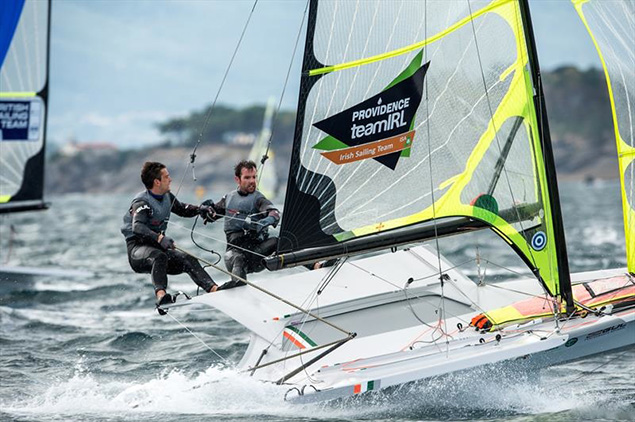 Ryan Seaton and Matt McGovern in action. Following the 2016 Olympics, they will now provide the 49er Class with two crews, as McGovern has teamed up with a new sailing partner, and Seaton is currently testing three different potential crewmates.
Ryan Seaton and Matt McGovern in action. Following the 2016 Olympics, they will now provide the 49er Class with two crews, as McGovern has teamed up with a new sailing partner, and Seaton is currently testing three different potential crewmates.
For some years now, the 49er in Ireland was all about Ryan Seaton and Matt McGovern from Belfast Lough, whose often lone pursuit of training competition and international championships was quietly heroic in itself, for with a different spin of the dice they might have been on the podium in 2012. Then they hit world headlines in 2016 by winning gold in Palma in April, and in Rio in August they had two race wins and were definitely contenders.
Also very much in the public eye were Andrea Brewster and Saskia Tidey of the RIYC in Dun Laoghaire, who made it into an Olympic 49er FX place at the last chance in February 2016, and then had the energies of top coach Tytus Konarzewski given over to them virtually full time in the buildup to Rio. The result was a more-than-respectable performance, and in all the intense Irish involvement in Olympic 49er campaigning was well justified.
This fitted very neatly with The Plan. It’s given all sorts of official titles, and reams of reports could be written about it, but basically since about 2014 James O’Callaghan has had three very promising young 49er crews in training, and they came on so well that by the end of 2014 they’d got to a stage he hadn’t expected to reach until early 2016, such that this week – albeit in a low key way – he is introducing a complete squad which will raise 49er sailing in Ireland, and for Ireland, to a new level.
This is in the knowledge that Matt McGovern has parted the ways with Ryan Seaton to set up a new 49er equipe with another crewmate, while Seaton is keen to stay in the game and he has three potential new partners in mind, though whether he’ll be testing any of them in the current programme in Dun Laoghaire remains to be seen.
Then there are the Nippers, Doug Elmes of Kilkenny and Colin O’Sullivan of Malahaide, the competent kids who took bronze in the 420 Youth Worlds in Malaysia at New Year, won the 420 Irish Opens during the summer going away, and then at the end of August suddenly appeared at their sailing base of Howth with their newly-acquired 49er, having leapt clean over any ideas of a 29ers or a 470 on the way.
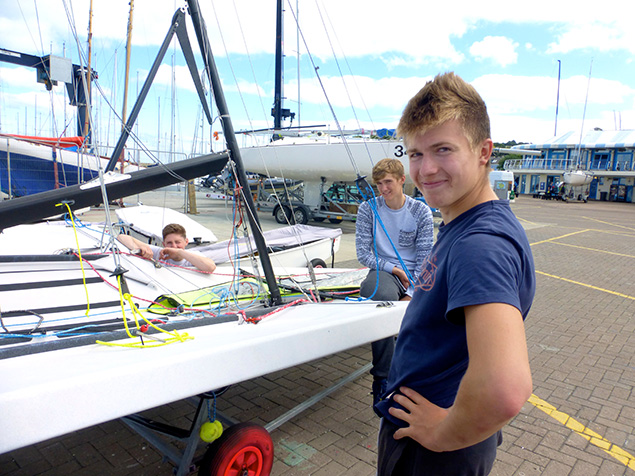
As for the 29ers, breeding ground for future 49er champs, the two Harrys – Durcan and Whittaker of Royal Cork – may be Ireland’s only active representatives, but they made a great job of it by winning the British Championship 2016, and now their sights are set on the 29er Worlds next year in California, but after that a 49er is surely the logical step.
Of course we’ve had waves of 49er interest in Ireland before – when it was new around 2000-2002, the class surged to maybe seven boats. What we’re looking at now is a comparable number, but there a depth to it that’s encouraging, and the three favoured young crews have been performing beyond expectation to provide a core for potential success well into the Olympic future.
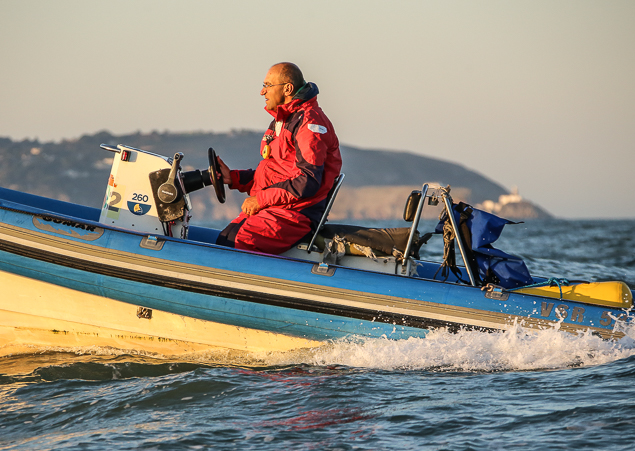 The Main Man. Tytus Konarzewski is one of Europe’s most respected sailing coaches, and the Irish 49er training squad have the use of his services until the end of 2016. Photo: Afloat.ie
The Main Man. Tytus Konarzewski is one of Europe’s most respected sailing coaches, and the Irish 49er training squad have the use of his services until the end of 2016. Photo: Afloat.ie
Thanks to the ISA’s Development and Youth Academies and Performance Pathways, and the quiet behind-the-scenes work by the Irish Sailing Foundation to add resources to funds coming from Sports Ireland, the work can go on. And although Tytus Konarzewski’s special talents were almost wholly devoted to coaching Andrea Brewster and Saskia Tidey in the six-month buildup to the Olympics, his contract runs to the end of 2016, and he’s now fulltime with the 49er crews, and there’ll be two more two-week training camps before the end of the year, both in Cadiz with one in November and the other in December.
 Making the best of light breezes and lumpy seas in Dublin Bay. Rob Dickson and Sean Waddilove, with the Donnelly brothers beyond. Photo: Afloat.ie
Making the best of light breezes and lumpy seas in Dublin Bay. Rob Dickson and Sean Waddilove, with the Donnelly brothers beyond. Photo: Afloat.ie
The three crews marked for destiny are Oisin O’Driscoll from Schull and Mark Hassett from Baltimore, Sean and Tadgh Donnelly from Dun Laoghaire, and Robert Dickson from Howth with Sean Waddilove from Skerries. In this year of all years, Irish sailors have some idea of just how much is involved in a campaign towards the Olympics. We wish them well, these young people and their supports teams.
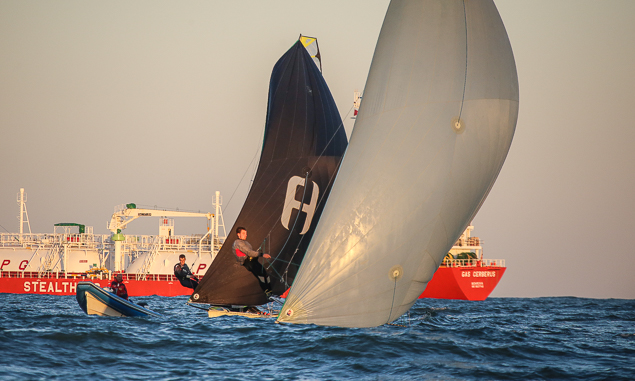 They say the truest good work is done by stealth, but we never thought to see it as clearcut as this…….The 49ers head into the sunset after making the most of an October evening. Their current training camp on Dublin Bay continues to the end of next week, and then training is resumed with another two week camp in Cadiz in November. Photo: Afloat.ie
They say the truest good work is done by stealth, but we never thought to see it as clearcut as this…….The 49ers head into the sunset after making the most of an October evening. Their current training camp on Dublin Bay continues to the end of next week, and then training is resumed with another two week camp in Cadiz in November. Photo: Afloat.ie
Mark Turner On Sorting Out The Dinghy/Olympic Sailing World
Mark Turner, the new CEO of the Volvo Ocean Race, has released his notes for a presentation to the ISAF Conference back in 2013 (now World Sailing) on how to develop the dinghy/Olympic sailing world to take it up a level.
Turner never gave the presentation. It is reported this morning by Scuttlebutt that just half an hour before he was due to speak, the ISAF Executive Committee for a reason he was never given directly or openly, decided to pull it.
Now Turner has released the content in a blog that can be accessed on Sailweb here. It makes interesting reading in the context of World Sailing's upcoming decisions on classes for Tokyo 2020 as has already been reported by Afloat.ie here.
New 'Performance Pathway Seminar' Series is Launched By ISA
In an exciting new initiative for youth sailors, the Irish Sailing Association has announced provisional details on a series of Performance Pathway Seminars.
The seminars are replacing the ISA Optimist Squads and ISA Topper Squad which have traditionally run from October to March. The change of tack does not affect summer activities which start after the ISA Pathway Nationals.
The seminars are primarily targeted at junior sailors from the Topper and Optimist classes and their coaches. There will also be sessions available to parents of sailors. Other applications may be considered.
There will be a minimum of three seminars over the winter and the topics will include but not be limited to Fitness, Psychology, Programme Design, Nutrition, Boat Transition, Olympic pathways.
The very clear switch to focussing on the education of young athletes means ISA Performance can widen the scope of how many athletes and coaches it can engage with over the course of the year. The ISA says 'the Pathway has often been criticised for not being inclusive enough so this initiative will tackle that concern head on'.
The ISA say 'Given our limited resources we feel this approach will give a better return on investment while at the same time giving the pathway much more visibility across a wider base. ISA Performance will NOT be running the ISA Optimist Squad or the ISA Topper squad this winter'.
There is additional investment going into the ISA coaching programme and it is hoped this programme will help facilitate the clubs and classes take on the role of training over the winter period.
As always the ISA Pathway Nationals will be the key event in the domestic programme. The ISA plan to invest more into the event and ISA Performance will continue to use this event to determine squads for the summer events.
Provisional Dates
OCT 29th & 30th
DEC TBC
JAN TBC
More Details and Application Process will be posted October 7th. In the meantime save the dates. It is envisaged we would have between 20 and 30 places per class association
Olympic Stardust Still Glistens At National Yacht Club
As the Olympic medal celebrations swing through West Cork this week, with today’s party taking over Skibbereen and its mighty Silver Medal winning oarsmen (and now World Champion) Gary and Paul O’Donovan writes W M Nixon, we’re still receiving souvenirs and feedback from last Thursday’s extraordinary seven hour programme of celebrations in Dun Laoghaire for Annalise Murphy’s Silver Medal from Rio de Janeiro.
There, the festivities took in the Harbour and went on to the People’s Park before reaching their peak at her sailing home, the National Yacht Club. In theory, the NYC clubhouse and its forecourt could not take a crowd of no more than 2,000 people. But this photo from the National Yacht Club of a section of the starstruck assembly at the height of the stage presentation suggests there were well over 2,000 there, still scarcely able to grasp the full significance of what they were seeing on a great night for Irish sailing.




























